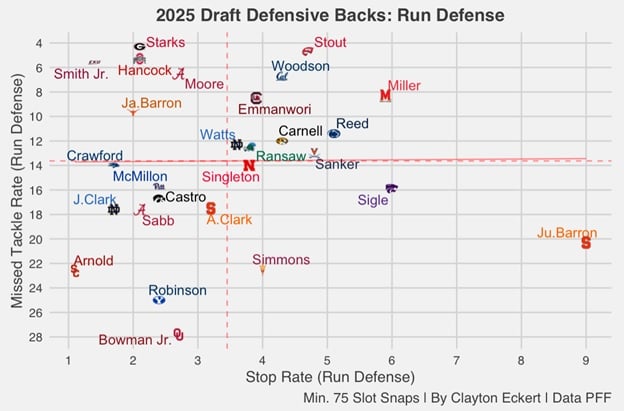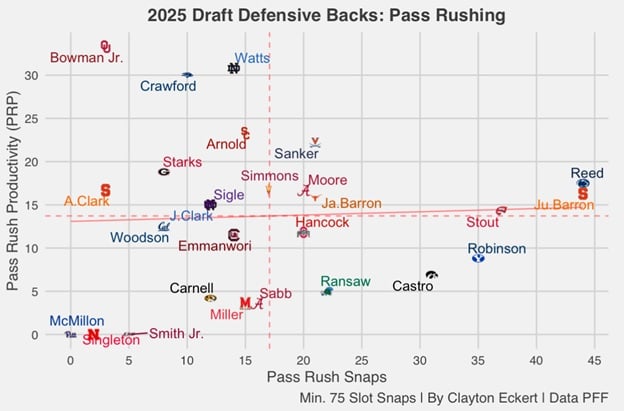It’s been quite some time since the Pittsburgh Steelers have had the right piece at slot corner. A carousel of experiments since Mike Hilton left in 2020 might suggest that it’s time to invest more after the most recent failure of Cam Sutton. Beanie Bishop Jr., a 2024 UDFA, is in the fold and did some good things last season, but a potential upgrade at the position should be considered.
Versatility is ideal at the spot, of course, in coverage, run defense and blitzing. The goal today is to look at the 2024 stats of defensive backs in the draft with at least 75 slot snaps (27 qualifiers). Seeing how they fared in coverage from the slot, along with their total run defense and pass rushing, will hopefully reveal quality options for Pittsburgh.
First, here are slot snaps and slot passer ratings allowed:
For starters, we can see which DBs had the most slot opportunities last season. Five players stick out with the most playing time in the slot, led by Arizona State’s Shamari Simmons. His 374 slot snaps comfortably led qualifiers (fourth-most in FBS in 2024), and had an average 84.4 rating allowed (15th/27).
Notre Dame’s Jordan Clark was second in slot snaps (328), with a comparable 85.0 rating against (16th). Kansas State’s Marques Sigle had 300 slot snaps (third), and the best 78.0 rating against with 250-plus slot snaps.
Two others had that many opportunities. Iowa’s Sebastian Castro’s 282 slot snaps rank fourth but fell well below other high-volume slot players with a 110.9 rating allowed (23rd). BYU’s Jakob Robinson had 274 slot snaps, with a stronger 92.9 rating against but still below average.
The next tier in slot opportunities were all slightly above the mean in slot passer rating allowed. Ohio State’s Jordan Hancock (226 snaps, 75.2 rating), Tulane’s Caleb Ransaw (203, 79.1), and Maryland’s Glendon Miller (202, 77.5).
Three others had above-average opportunities but less than-ideal coverage results: Georgia’s Malaki Starks (175 snaps, 94.2 ratings), Missouri’s Daylan Carnell (171, 92.8), and Western Kentucky’s Upton Stout (164, 92.7).
Then, there are clear tiers of above and below the mean ratings against for players utilized less in the slot. Here are the top five in slot passer rating allowed: Nevada’s Kitan Crawford (22.6, 86 snaps), Jahdae Barron of Texas (41.1, 18), California’s Craig Woodson (49.6, 93), Pittsburgh’s Donovan McMillon (57.1, 91), and Alabama’s Malachi Moore (59.0, 114). These are nice numbers, particularly Crawford’s 22.6, the sixth-best in the FBS.
Five more had above-average ratings against but below the mean snaps: Notre Dame’s Xavier Watts (64.1, 98), Virginia’s Jonas Sanker (65.0, 92), Syracuse’s Justin Barron (70.8, 92), South Carolina’s Nick Emmanwori (73.2, 79), and Eastern Kentucky’s Mike Smith Jr. (78.8, 108).
Then, a clear tier on the lower left of players who lacked quality and quantity in slot coverage. Of course, the hope was a strong balance of both, but unfortunately, no players on the upper right of the chart emphasizes a lack of a true standout.
Let’s layer in run defense, using stop and missed tackle rates:

Justin Barron had a stellar 9.0 run stop rate, three points higher than any other qualifier, impressively. He posted a well below average 20.3 missed tackle rate against the run, though (23rd), so literally hit or miss. Starks had the best 4.3 missed tackle rate but paired that with a 2.1 stop rate (T-21st).
Stout was second in missed tackle rate (4.7) with a matching number in stop rate (sixth), making his 2024 run defense offerings one of the most balanced of the group. He’s one of nine that landed above the mean in both.
The rest of that list includes Miller (5.9 stop rate – third, 8.3 miss rate – seventh), Woodson (4.3 – T-seventh, 6.7 – sixth), Penn State’s Jaylen Reed (5.1 – fourth, 11.4 – tenth), Emmanwori (3.9 – tenth, 8.5 – eighth), Carnell (4.3 – T-seventh, 12.0 – 11th), Sanker (4.8 – fifth, 13.0 – 14th), Ransaw (3.8 – T-11th, 12.5 – 13th), and Watts (3.6 – 13th, 12.3 – 12th).
Now for pass rushing, using pass rush snaps and pass rush productivity (formula that combines sacks, hits, hurries, and pass rush snaps):

Once again, the chart is devoid of players on the top right. The three players that rushed the passer most also landed above the mean (slightly) in productivity. Reed and Justin Barron tied for the most pass rushes of the group, with PRP of 17.5 (seventh) and 16.3 (11th). Stout was third with 37 pass rushes, just above the mean in PRP (14.3, 15th).
Then, four more DBs landed at or above the mean in both: Sanker (22.2 PRP – fifth, 21 snaps – T-seventh), Moore (16.7 – T-eighth, 20 – T-ninth), Simmons (16.7 – T-eighth, 17 – 11th), and Jahdae Barron (15.8 – 12th, 21 – T-seventh).
Two other players had 30-plus pass rushes: Robinson (35) and Castro (31), but lower PRP of 8.8 (19th) and 6.9 (20th) were below average among their peers. Three players stuck out with impressive PRP, maximizing on less opportunity. Oklahoma’s Billy Bowman Jr. (33.3 PRP – first, three snaps), Watts (30.8 – second, 14), and Crawford (30.0 – third, ten).
Conclusion
It’s pretty difficult to check every box at the slot CB position, and interestingly, the study revealed that the draft community would label a vast majority of the qualifiers as safeties. The player with the most balanced stats was Jonas Sanker, with slot coverage snaps being his only below-average result.
That’s an important one, though, with experience being invaluable. Marques Sigle and Shamari Simmons had much higher slot snaps. Lower marks for the former were missed tackles in run defense, and below-average pass rush snaps. Simmons impressed overall, with missed run tackles also being his most apparent weakness last season.
Miller did some nice things in 2024, but a clear negative was his pass-rush production. Stout rounds out the top five of the cumulative stats, but his worst stat was slot passer rating allowed. It’s early, but seemingly, none of the five names listed above would require a high pick investment, which would be great to address other positions early.
Though he had fewer slot coverage snaps, I liked what I saw from Watts. He has good coverage, run defense, and pass-rush production and could be a good earlier-round option. There are several other names I could discuss further, but from a stats perspective, this is the shortlist that I think could be an answer for the Steelers at slot corner.
